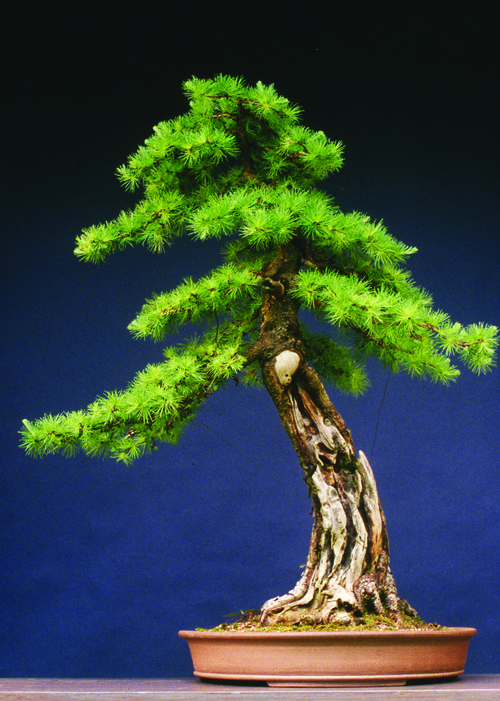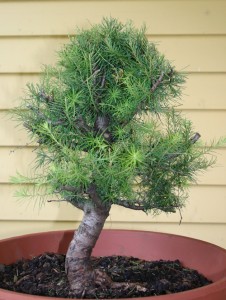
Nick Lenz calls this rugged heavily scarred old larch a ‘super hack back job’ (performed with a chainsaw). It’s noteworthy for its excellent taper and nebari (among other things), things that doesn’t come naturally with most larches. I guess you could say that the Halloween carving is also noteworthy. The photo is from Nick’s book, Bonsai from the Wild (Stone Lantern Publishing).
Round these parts it’s a Tamarack
Here in Vermont we are right on the southern edge of the Larix laricina’s range. Most bonsai enthusiasts (and many others) refer to it as the American larch, but around here almost everyone calls it the Tamarack.
So many good qualities
Of all the trees that grow around here, larches are the most prized bonsai candidates. They are easy to grow, flexible, take to pruning and root pruning, have small bright green needles and excellent fall color, the wood is easy to carve and the resulting deadwood is attractive, they develop real character with age, and so forth…

This rugged old naturally dwarfed larch is makes its home in the middle of a somewhat barren and boggy, larch-friendly field. Nick Lenz says that trees like this one with plenty of deadwood are often riddled with borers and that the gems are usually found in the smaller mounded forms (if you look close, you can see some). This photo is also from Nick’s book, Bonsai from the Wild.
And quite unique in their own right
Larches are abundant in these parts, especially in the boggy lowlands. However, because they are conifers that happen to be deciduous, they are unique among the world’s trees (there are only three or four – depending how you classify – deciduous conifers in the world). This gives larches a special cache, as well as a bright yellow fall color.

This famous bonsai (also from Nick’s book) gives you a pretty good idea of why larches are valued for their seductive yellow-golden fall foliage.

A little man-made rocky hill in my back yard that doubles as a bonsai field growing area. You can see about twelve different species in this shot (excluding the big trees in the back) including several larch. If you are interested in more on field growing, here’s the latest in a series of posts we have been running.
Not ready yet
I’ve been collecting young larch for about five years and growing them on. They are all are still fairly small and need to stay in the field for many more years to age and gain some character, so none are really developed enough to show you much. Nevertheless, here’s a couple photos to give you some idea of what’s going on. Meanwhile, for the real goods, we always have Rarch Master Renz’s (Larch Master Lenz’s) trees to enjoy.

Here’s one I dug up on a friend’s farm and stuck in my yard for about four years. There trunk is almost 2″ (5cm) thick just above the root that flares out on the right. As you can see, it lacks good taper, which is a common drawback with larches. This year I decided it was time to do a little work on it, so that’s why its in a training pot. I ended up butchering it a bit (some people call it carving) and then sticking it back in the ground. As is often the case, I neglected to take photos. BTW: This photo and the one above are by my friend Amy Plamer, one person who does have the wherewithal to remember her camera.
i’m a huge fan of the larch but finding a place to collect larch is hard if someone knows a good place to collect please let me know memphis550@yahoo.com
Are you in Memphis? If so, you’re going to have to travel some. I’ve seen some good ones from bogs in Maine and Nick Lenz mentions lakeshores and parts of the Adirondacks, as well as Cape Breton Nova Scotia in his book http://www.stonelantern.com/Bonsai_from_the_Wild_2nd_ed_p/b1lenz.htm.